How to make Classic Profiteroles
These lovely classic homemade profiteroles are delightful little choux pastry puffs, each filled with silky vanilla cream, or fluffy whipped cream.
The light and crisp exterior gives way to the smooth, creamy centre. Dip in chocolate or caramel for a decadent dessert packed full of rich and luxurious flavours.
Tower them into a dramatic croquembouche for a show stopping dessert centre piece at any special occasion.
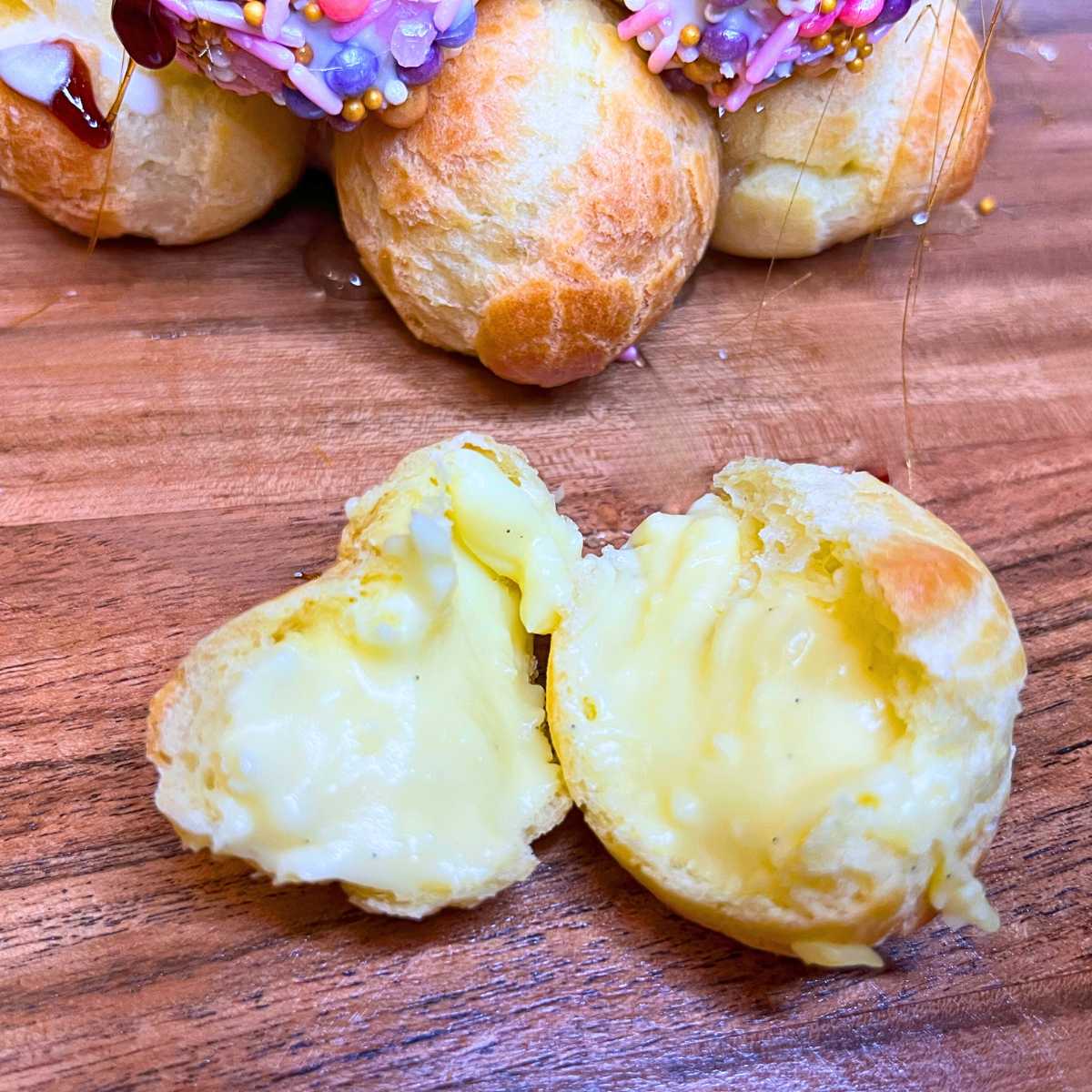
What are profiteroles?
Profiteroles are made from pâte à choux, or choux pastry. The word choux translated to English, means cabbage. So the pastries resemble little cabbages.
Choux pastry is cooked on the stove before it is baked in the oven. It is a very light and airy pastry. This makes it the perfect vessel for filling with things like cream and custard. This is the same type of pastry that you would use for eclairs.
Bite-sized profiteroles are easy to pickup and eat with your fingers. A perfect recipe for parties and get togethers to serve alongside appetizers and finger foods.

Filling Profiteroles
Profiteroles, or cream puffs, are typically filled with pastry cream or whipped cream. However, since profiteroles are light-as-air pastries that have a lot of hollow space inside, you could really fill them with anything, like chocolate mousse, ice cream, or lemon curd.
Even savoury fillings are delicious in profiteroles like garlic and herb cheese, bruschetta, or spicy chicken.
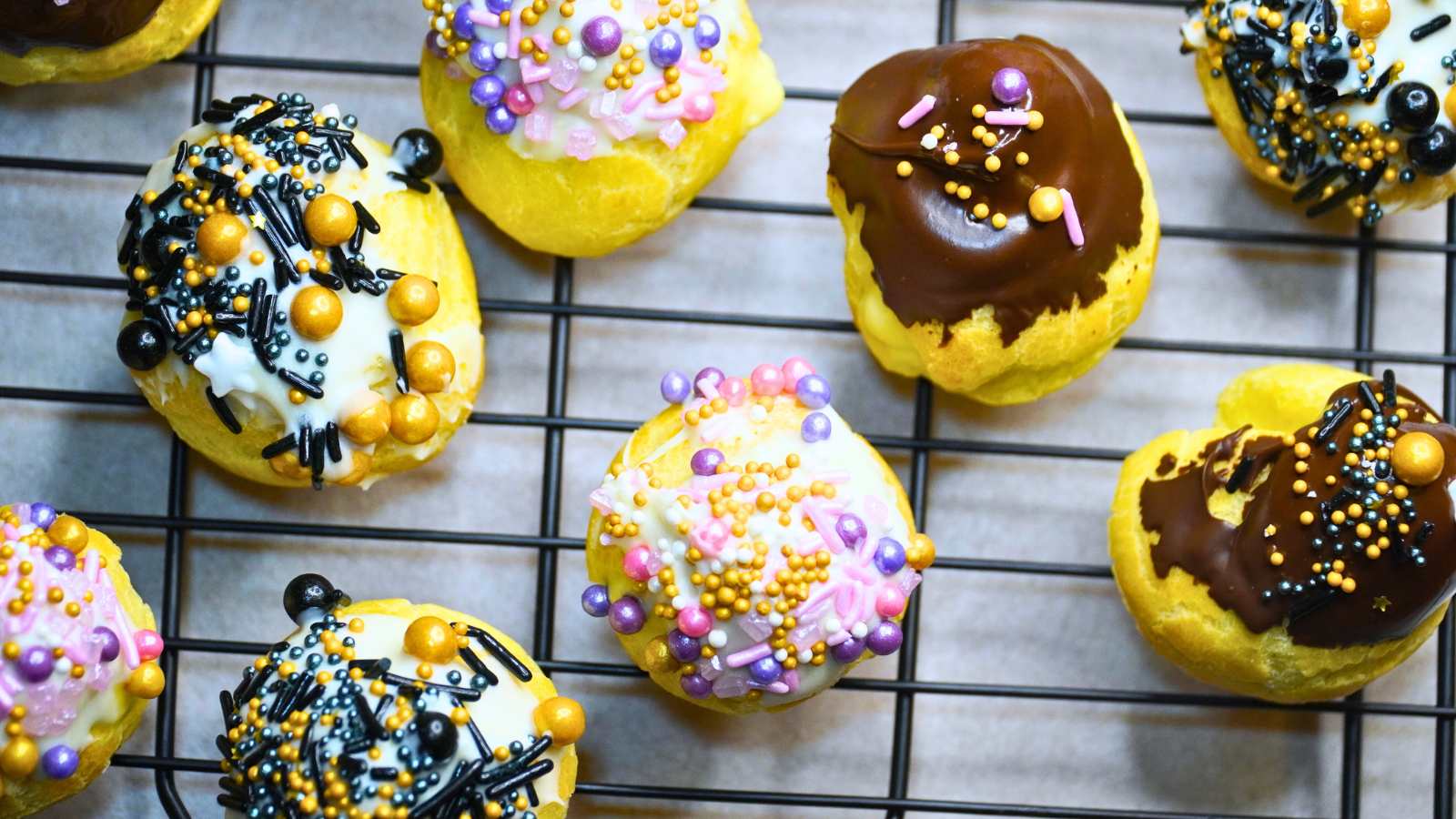
To fill profiteroles with a soft creamy mixture, like the classic pastry cream or whipped cream, it is best to use an piping bag. If you do not have one, make a simple homemade piping bag with a plastic sandwich bag. Cut a small hole at the corner, to extrude the filling.
To fill profiterole with a chunky mixture like bruschetta or chicken, cut the top third of the pastry off and fill the inside with the mixture. Then, reapply the top.
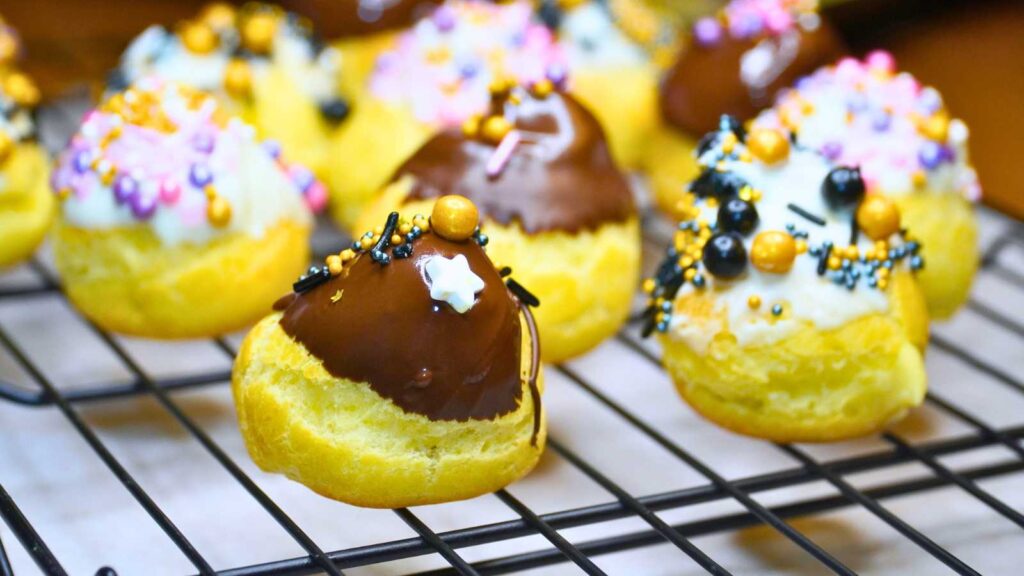
How to Store Profiteroles
Room Temperature
Store unfilled profiteroles in an airtight container at room temperature for up to 2 days.
Refrigerator
Store leftover profiteroles in an airtight container in the refrigerator. For profiteroles filled with pastry cream or other perishable fillings, consume within 2-3 days.
The filling can become watery and the pastry will become soggy, if stored longer.
Freezer
Freeze profiteroles in a single layer, on a baking sheet, for 1-2 hours. Then, transfer to an airtight container. This will allow the filling to harden. This way, when you are stacking them to place in the freezer, the soft filling will not ooze out.
Store in the freezer for 1-2 months. When you are ready to use them, defrost in the refrigerator 24 hours.
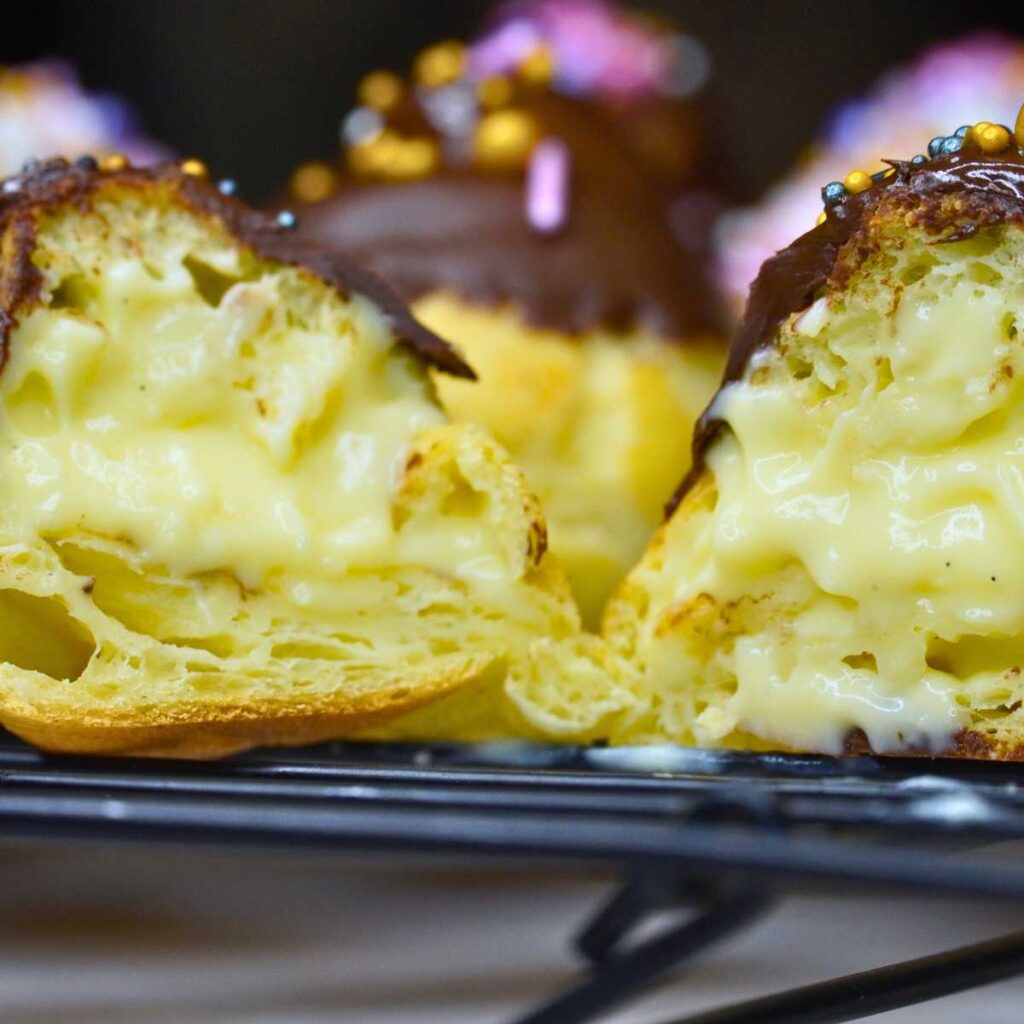
Making Profiteroles in advance
To make profiteroles in advance, it is best to store the filling and the profiteroles separately. Storing prefilled profiteroles in the refrigerator will result in a cold, soft pastry. Instead of the light crisp crust from a fresh profiterole, or one stored unfilled at room temperature.
Store unfilled profiteroles in an airtight container, at room temperature, for 2 days.
The pastry cream can also be made 1-2 days in advance and stored in the refrigerator. Make sure to place a piece of cling-film right on top of the cream. This will prevent a skin from forming.

Croquembouche
A croquembouche is a tall, dramatic, tower of profiteroles. The profiteroles are stuck together with a smooth caramel that dries hard and is extremely strong.
This profiterole recipe will make enough for 1 medium croquembouche. I use a cone form on the inside to shape the croquembouche, which also takes up space. If you are making a larger tower or if you are not using a cone to form the croquembouche, double the recipe.
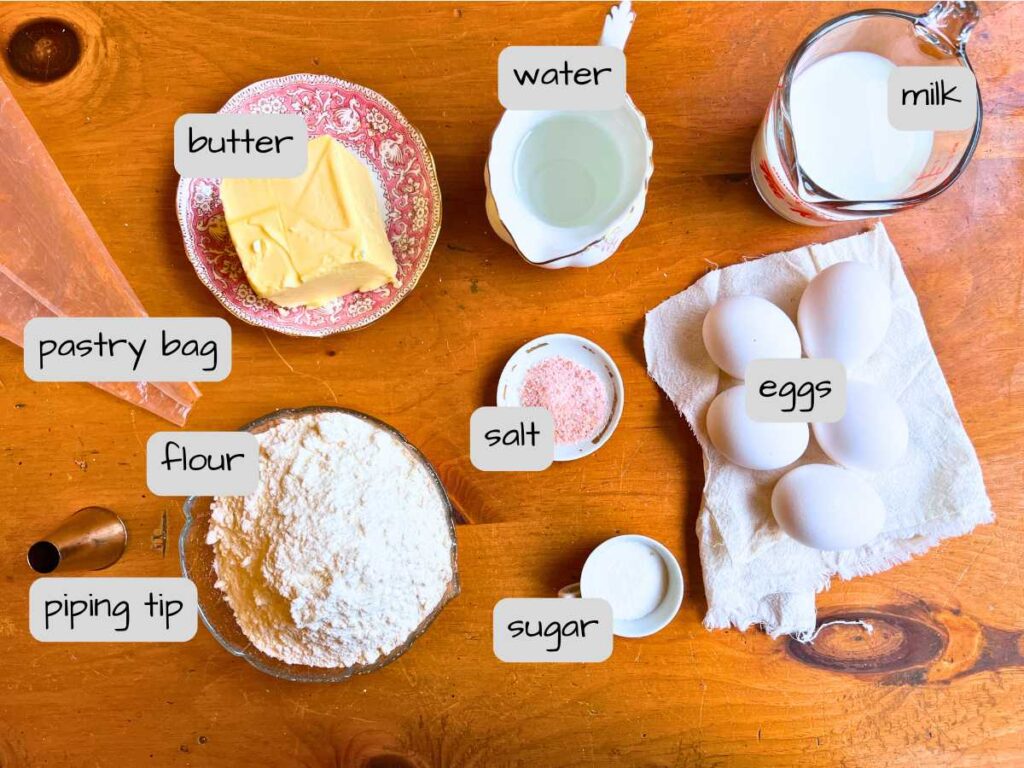
Ingredients for Profiteroles
¾ cup milk 175 ml
¾ cup water 175 ml
⅔ cup softened butter 150 g
1 Tablespoon sugar 12 g
½ teaspoon salt 2 g
1 ⅔ cup all-purpose flour 250 g
5 eggs
Method
- In a medium sauce pot, over medium-high heat, add the milk, water, butter, sugar, and salt.
- Bring the mixture to a simmer.
- Reduce the heat to medium-low and add in the flour.
- Stir it with a strong wooden spoon, until the flour is incorporated and is a smooth soft dough ball that cleans the sides of the pot.


5. Using a stand mixer, with the paddle attachment, or a large bowl with beaters, place the dough into the bowl and mix on medium for about a minutes to cool down the dough enough to add in the eggs.
6. With the mixer still going, add in the eggs, one at a time. Beat well after each addition to incorporate the eggs.
7. Transfer this mixture to a very large piping bag with a large circular tip. Or you can use a large freezer bag and cut a small hole in one corner to make a DIY piping bag.
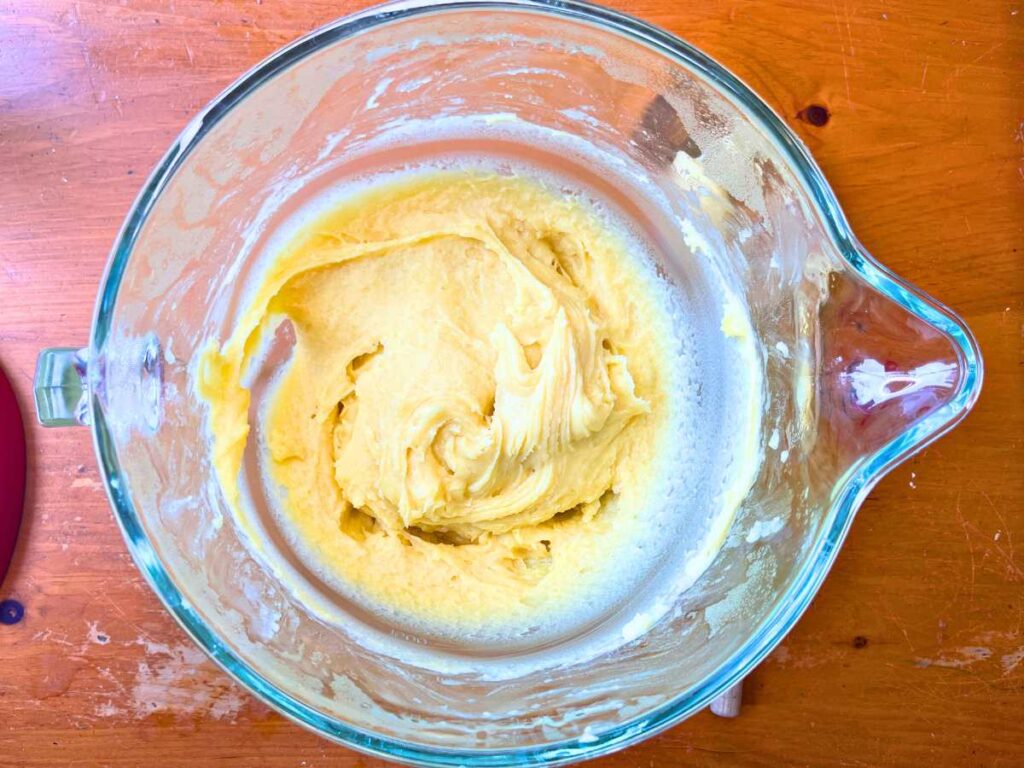
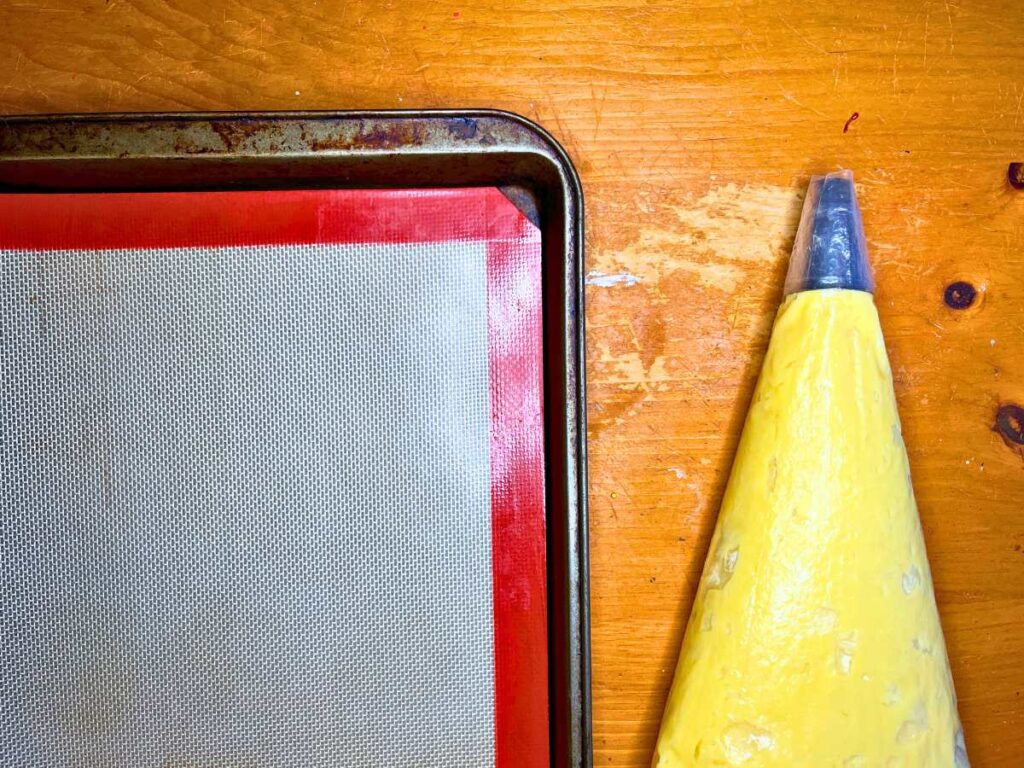
8. Pipe about a Tablespoon worth of dough onto a lined baking sheet, about 1 ½ inches apart.
9. Dip your finger into a small glass of water and smooth down any points at the top of the dough that were left from the piping bag.
10. Preheat the oven to 400 °F (200 °C).
11. Bake the profiteroles for 10 minutes at the high temperature to give them a big burst of heat, which will help them puff up.
12. Reduce the temperature to 375 °F (190 °C) and continue to bake for 15 minutes, or until the profiteroles are golden brown and feel very light and airy. (If profiteroles are not baked long enough, they will collapse as they cool.)
13. Cool completely before filling.
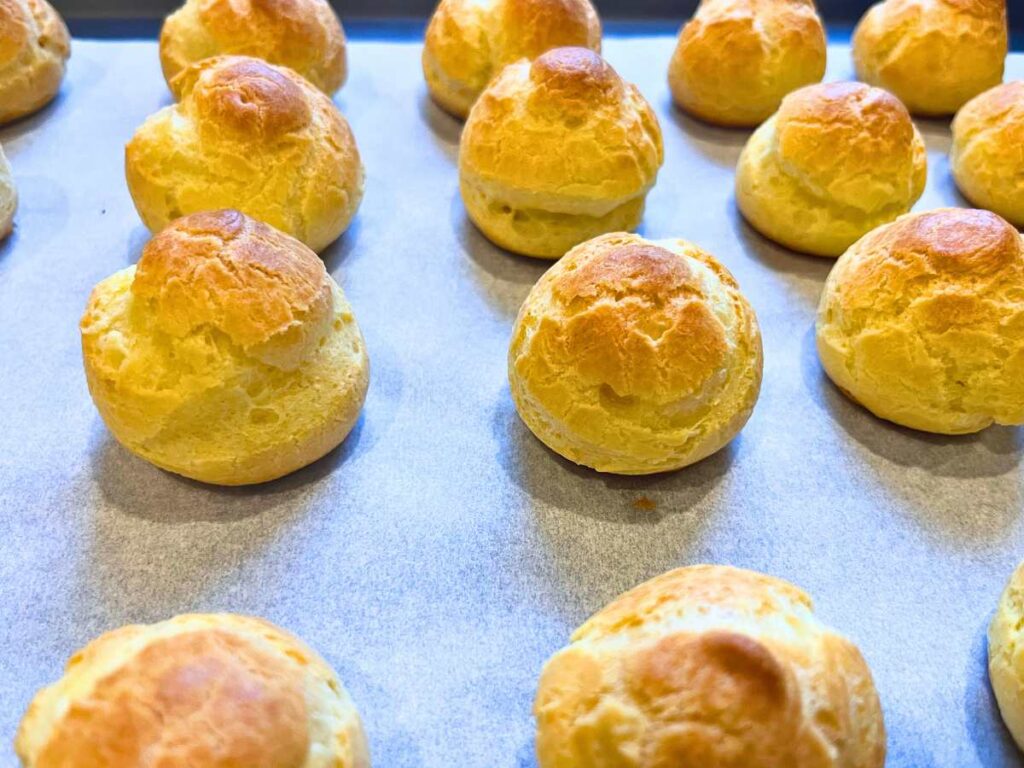
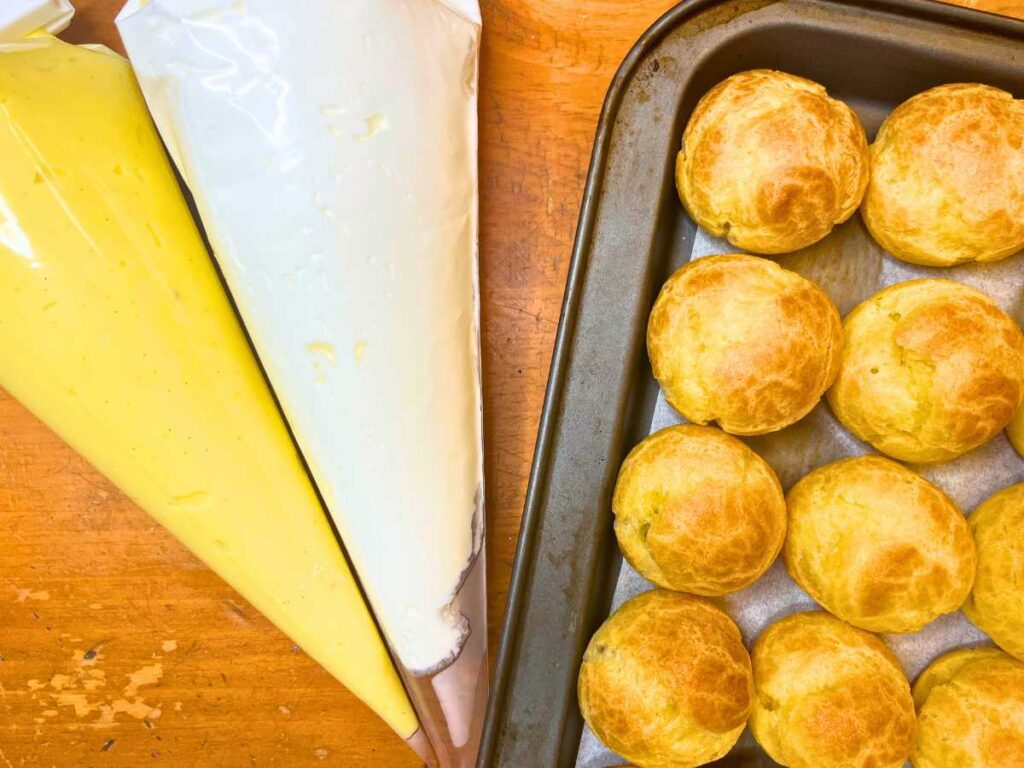
Filling and assembly
- Prepare your filling of choice.
- If the filling is smooth and creamy like pastry cream, place it in a pastry bag with a small tip or a sandwich bag with a small hole cut in the corner.
- Poke the tip into the profiterole, (you should be able to see a weak spot in the pastry). Pipe in the filling until the pastry feels noticeably heavier in your hand.
- Continue with the rest of your profiteroles.
- If you are using a chunkier filling like a meat or vegetable mixture, cut off the top 1/3 of the profiterole and fill the inside cavity.
- Once full, replace the top. Set aside and continue filling the rest.
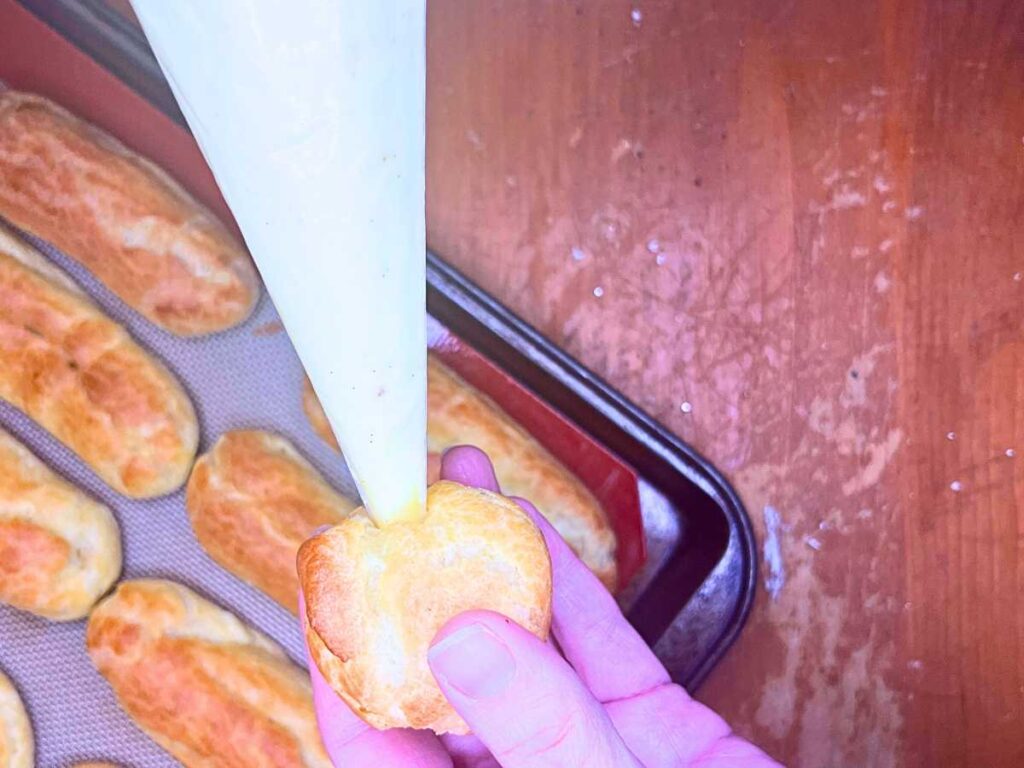

- For an added flourish profiteroles can be drizzled with melted chocolate, dipped in caramel, or dusted with icing sugar.
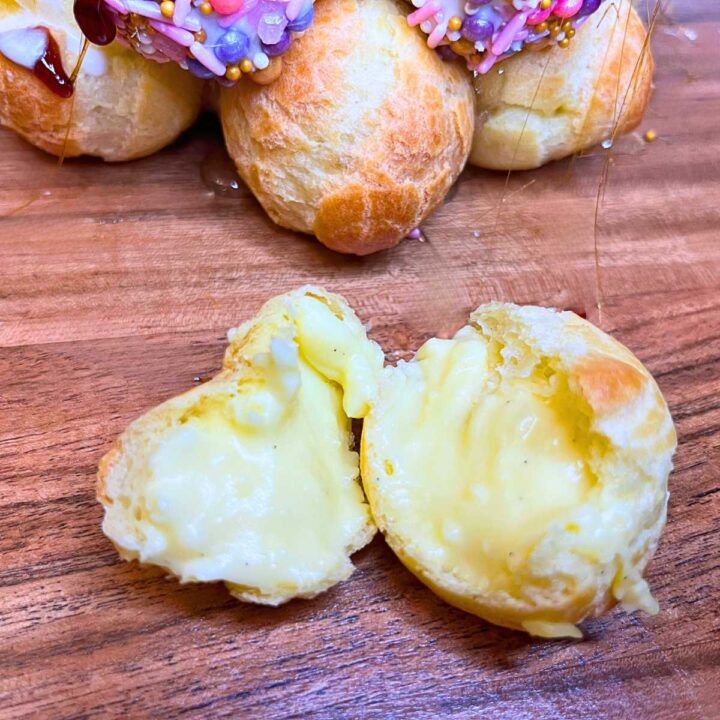
Classic Profiteroles
Light and airy pastries is a delicate crispy crust. Perfect for stuffing with rich and decadent sweet or savoury fillings.
Ingredients
- ¾ cup milk 175 ml
- ¾ cup water 175 ml
- ⅔ cup softened butter 150 g
- 1 Tablespoon sugar 12 g
- ½ teaspoon salt 2 g
- 1 ⅔ cup all-purpose flour 250 g
- 5 eggs
Instructions
- In a medium sauce pot, over medium-high heat, add the milk, water, butter, sugar, and salt.
- Bring the mixture to a simmer.
- Reduce the heat to medium-low and add in the flour.
- Stir it with a strong wooden spoon, until the flour is incorporated and is a smooth soft dough ball that cleans the sides of the pot.
- Using a stand mixer, with the paddle attachment, or a large bowl with beaters, place the dough into the bowl and mix on medium for about a minutes to cool down the dough enough to add in the eggs.
- With the mixer still going, add in the eggs, one at a time. Beat well after each addition to incorporate the eggs.
- Transfer this mixture to a very large piping bag with a large circular tip. Or you can use a large freezer bag and cut a small hole in one corner to make a DIY piping bag.
- Pipe about a Tablespoon worth of dough onto a lined baking sheet, about 1 ½ inches apart.
- Dip your finger into a small glass of water and smooth down any points at the top of the dough that were left from the piping bag.
- Preheat the oven to 400 °F (200 °C).
- Bake the profiteroles for 10 minutes at the high temperature to give them a big burst of heat, which will help them puff up.
- Reduce the temperature to 375 °F (190 °C) and continue to bake for 15 minutes, or until the profiteroles are golden brown and feel very light and airy. (If profiteroles are not baked long enough, they will collapse as they cool.)
- Cool completely before filling.
Filling and Assembly
- Prepare your filling of choice.
- If the filling is smooth and creamy like pastry cream, place it in a pastry bag with a small tip or a sandwich bag with a small hole cut in the corner.
- Poke the tip into the profiterole, (you should be able to see a weak spot in the pastry). Pipe in the filling until the pastry feels noticeably heavier in your hand.
- Continue with the rest of your profiteroles.
- If you are using a chunkier filling like a meat or vegetable mixture, cut off the top ⅓ of the profiterole and fill the inside cavity.
- Once full, replace the top. Set aside and continue filling the rest.
Notes
To add an extra flourish, profiteroles can be dipped, drizzled, and dusted with things like chocolate, caramel, and icing sugar.
Nutrition Information
Yield
30Serving Size
1Amount Per Serving Calories 83Total Fat 5gSaturated Fat 3gTrans Fat 0gUnsaturated Fat 2gCholesterol 42mgSodium 60mgCarbohydrates 7gFiber 0gSugar 1gProtein 2g
Nutrition information isn’t always accurate.
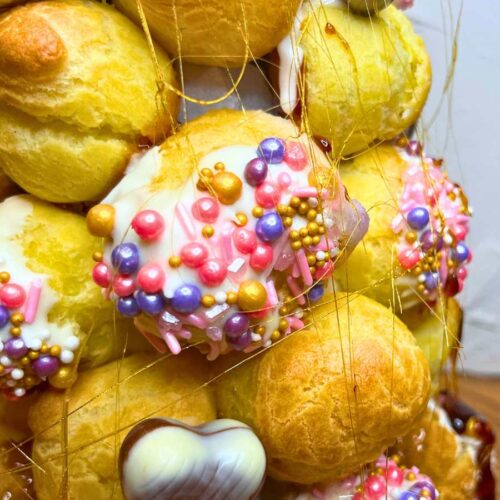
Vanilla Pastry Cream
Equipment
- 1 strainer
Ingredients
- 4 cups milk
- seeds from one vanilla bean
- ¾ cup sugar
- 12 egg yolks
- ½ cup cornstarch
- ½ cup cold butter cut into cubes
Instructions
- To a large sauce pot over medium heat, add the milk
- Scrape the seeds from one vanilla bean and add to the milk.
- Heat until it starts to steam but before it starts to simmer and form bubbles.
- Remove from heat and set aside to steep.
- Meanwhile, in a large bowl combine the sugar, cornstarch and egg yolks.
- Whisk until it is light and creamy.
- In a new large bowl, add the cubes of butter. Place a strainer overtop of this bowl, set aside.
- Now the milk should be ready. Gently, and gradually, pour a little bit of the hot milk into the egg and sugar mixture, whisking constantly.
- Pour the egg and milk mixture back into the sauce pot and return it to medium heat. Stirring until it is glossy and thickened.
- As soon as you see a few bubbles form, from it beginning to simmer, remove it from the heat and pour it through the strainer, onto the cold butter.
- Remove the strainer, and stir everything together.
- Place a piece of cling-film on top of the pastry cream. Allow to cool completely before using. The cling-film will stop it from forming a skin.
Hungry for more delicious party and finger foods? These are some of my favourites!
Don’t forget to sign up to receive all the best vintage recipes and old-fashioned skill right to your inbox and gain access to the FREE printables library! I’m adding new things all the time, like this!

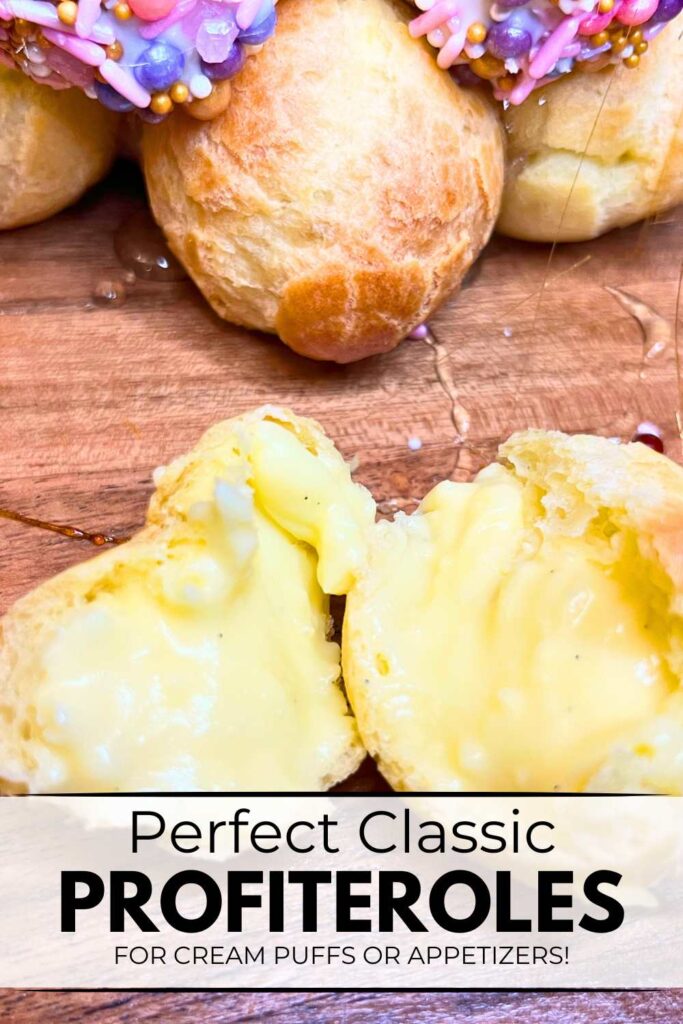

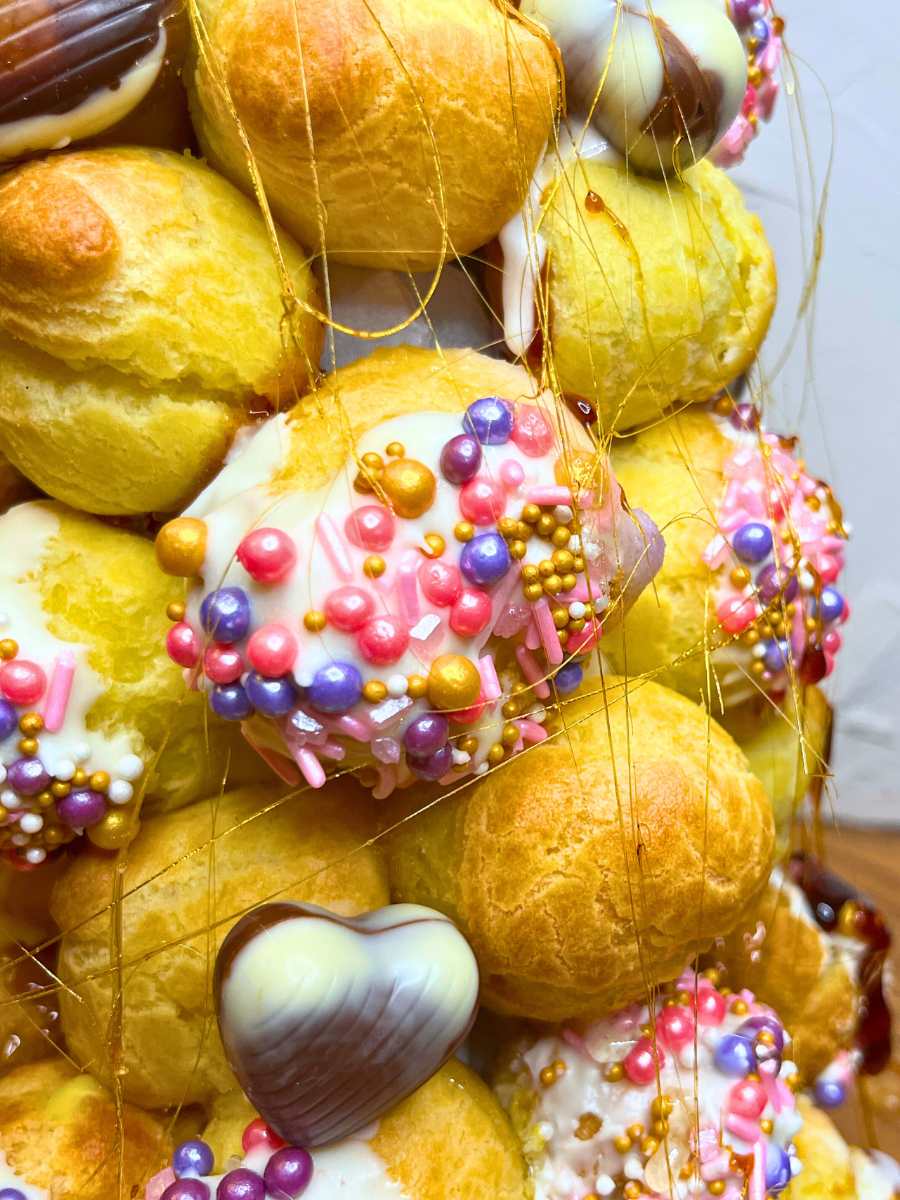

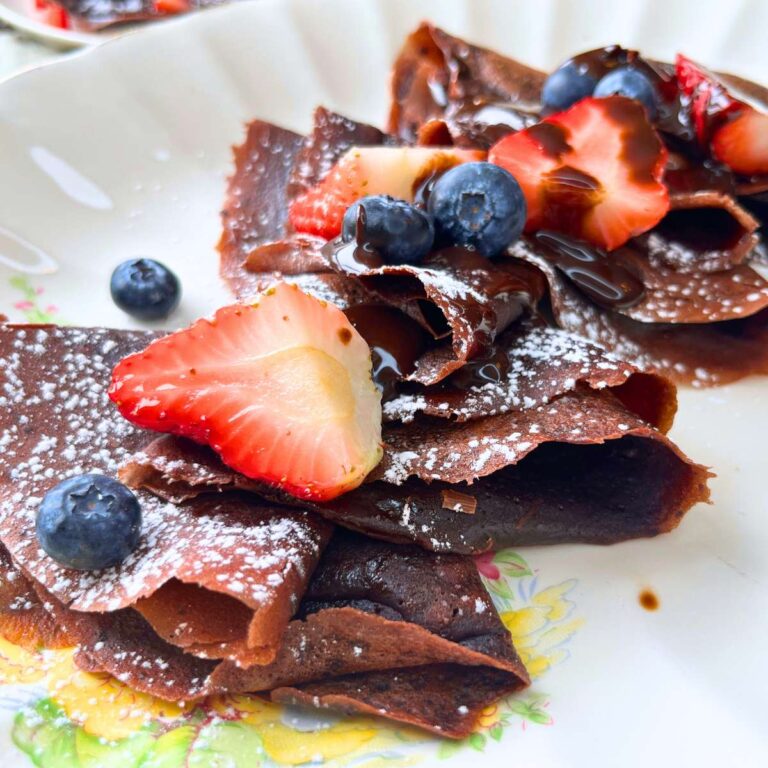
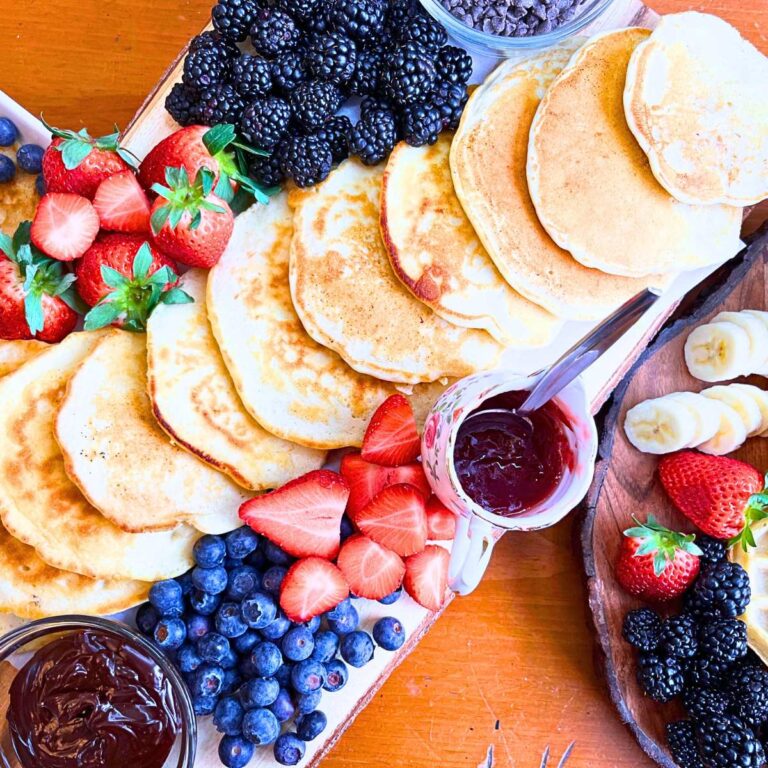

2 Comments